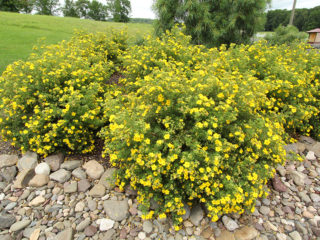Content
Cinquefoil, or shrub cinquefoil, is an unpretentious plant of the Rosaceae family with a wide growing area. In the wild, it can be found in mountain and forest areas, in river floodplains, along riverbeds, among stones and in damp, swampy places. Due to its good decorative properties, the plant has been cultivated for a long time. Currently, about 130 varieties of cinquefoil shrub are known, differing in stem height, crown density, foliage structure, and shades of flowers. Very interesting is the Belissimo cinquefoil - a dwarf form belonging to this species.
Description of Potentilla Belissimo
Potentilla Fruticosa Bellissima is a compact low shrub with a branched crown. Its height does not exceed 30 cm. At the beginning of summer, it throws out a large number of semi-double, bright pink flowers with a diameter of up to 5 cm. Replacing each other, they bloom all summer, until the arrival of October. The light green leaves of the Belissimo cinquefoil darken over time, acquiring a silvery tint and slight pubescence.
Belissimo cinquefoil loves sunlight. For good growth, it needs loose, fertile, sufficiently moist soil. The shrub is hardy, tolerates adverse weather conditions well and can grow even in permafrost conditions. The variety is very decorative, loved by many gardeners, and widely used in the construction of landscape compositions.
Planting and caring for Belissimo cinquefoil
Planting and caring for Belissimo cinquefoil is quite simple. It responds to attention and fences with lush and long-lasting flowering.
Preparing the landing site
Preparatory work begins with choosing a suitable landing site. The light-loving plant likes open areas, illuminated by the sun most of the day. But for brighter flowering, slightly shaded places are chosen.
Like all representatives of the Rosaceae family, Belissimo shrubby cinquefoil grows well in light, sandy, moderately moist soil. Areas with dense, clayey soil should not be chosen for it. In order for the plant to grow faster, it is planted in a nutrient mixture, which is prepared independently according to the following scheme:
- leaf soil (2 parts);
- compost (2 parts);
- sand (1 part);
- complex mineral composition (150 g per well).
Soil acidity pH should be in the range of 4.5 - 7. Higher values are contraindicated for the plant. Excessively moist and too calcified soil is also not suitable.
Before planting Belissimo cinquefoil, you need to take care of organizing a drainage system of large pebbles or crushed stone to protect the root system from rotting.Alkaline soil is not an obstacle to planting.
Landing rules
The holes for planting Belissimo cinquefoil begin to be prepared in advance so that the soil has time to acquire the required density. Make depressions or trenches, removing the soil by half a meter. A layer of drainage 15-20 cm thick is placed at the bottom. It is best to use limestone gravel for this, but you can use pebbles or fragments of bricks. Having completed the preparation, the holes are left open for a while.
When planting Belissimo cinquefoil, fill the holes halfway with the prepared nutrient mixture. Planting is carried out as follows: the seedling is placed in a hole, the root system is carefully straightened and sprinkled with soil removed during digging so that the root collar remains on the surface. Between two adjacent plants you should leave about 30 cm (when forming a hedge) and about 1 m (when planting single specimens).
Belissimo cinquefoil seedlings are also being prepared for planting. Inspect the roots and trim them a little. A branched root system will ensure good survival rate.
Watering and fertilizing
One of the prerequisites for good growth of Belissimo cinquefoil is loose, sufficiently moist soil. The culture is drought-resistant, but at the same time does not tolerate prolonged drying out of the roots.
During the rainy season, natural watering is sufficient for adult plants. During drought, they are watered twice a week, the norm for a bush is 3 liters of water.
After watering, deep loosening is carried out to saturate the roots with oxygen. The tree trunk circle is covered with mulch.
Feeding the bushes should be done carefully. Adding too much nutrient mixture will cause rapid growth of green mass, but will inhibit flowering.
The first time the Belissimo cinquefoil is fed is a year after planting. This is done in three stages: in May, July and the end of August. It is recommended to choose a complex mineral fertilizer for flowering plants with a potassium-phosphorus composition. You can also use organic matter (an aqueous solution of ash and humus).
Trimming
Proper care of Belissimo cinquefoil bushes is impossible without regular pruning of the bushes. It is necessary to remove weak and diseased shoots, long, thin branches that break the shape of the crown and reduce flowering activity. Three types of pruning are used:
- Sanitary pruning - carried out regularly throughout the growing season. During this process, carefully inspect the bush and carefully trim dry, thin, damaged shoots, as well as faded buds.
- Formative or stimulating pruning - Held in spring and early autumn. With its help, they stimulate the growth of powerful young branches that form the base of the crown, shortening the branches by about a third and thus creating a beautiful, rounded crown. In addition, part of the lower, leafless shoots is removed.
- Anti-aging pruning - carried out on old plants once every few years: the branches are shortened by about 10 cm to give rise to the development of new shoots and crown renewal.
Preparing for winter
Cinquefoil shrub Belissimo is a frost-resistant variety. Adult plants are not covered for the winter. Preparing for cold weather involves sanitary pruning and removing withered leaves.
Young seedlings are earthed up in the fall by adding a thick layer of peat or humus to the trunks. The top is covered with spruce branches or special covering material.To protect Belissimo cinquefoil from severe frosts, make an air-dry shelter under plastic film.
Reproduction of Potentilla Bellissima
A description of Belissimo shrubby cinquefoil will be incomplete without talking about methods of reproduction. There are several of them, and each has its own advantages and disadvantages.
Seeds
The method of propagation by seeds is used quite rarely for the following reasons:
- the period of development of seedlings from seeds is quite long (up to 4 years);
- there is a possibility of loss of varietal characteristics.
Belissimo cinquefoil seeds are sowed in greenhouses or individual containers using a moistened nutrient mixture. In winter they are grown in a warm room, transplanted into the ground in the spring, after the morning frosts have gone.
Cuttings
Planting material is obtained as follows: from powerful side shoots of the bush, cuttings 8 to 10 cm long are cut so that each of them has a so-called “heel” - an area covered with wood. They are treated with a root formation stimulator and left for the winter, rooted in a nutritious mixture of peat and sand (the height of the “crown” above ground level is 2 cm). You can also store cuttings in a shady, well-ventilated area at a temperature of 5 to 10 ° C. In the spring, rooted seedlings are placed under film and grown throughout the year. After a year, the stronger plants are planted in a permanent place in open ground.
Dividing the bush
To propagate Belissimo cinquefoil by division, choose powerful 3-4 year old bushes. They are carefully dug up and cleared of soil.The roots are washed and divided into parts so that each has 3 - 4 renewal buds and a small root. The root part is treated with a root formation stimulator and planted in specially prepared holes so that the renewal buds are not buried in the ground. You should maintain a distance between bushes of about 40 cm.
Diseases and pests
With proper care, Belissimo cinquefoil becomes a healthy, strong plant, not susceptible to disease and pest attacks.
The most common cause of diseases is an incorrectly chosen planting site and unsuitable soil. Too heavy, waterlogged soil and lack of sunlight cause root rot. In this condition, the plant may develop a fungal infection: rust, leaf spot, powdery mildew.
Belissimo cinquefoil bushes planted in close proximity to coniferous plants are also in danger: coniferous crops are carriers of rust fungus spores.
Having discovered signs of fungal damage, measures are taken to dry the soil. The bushes are treated with preparations based on copper, boron or manganese (Fitosporin, Bordeaux mixture).
Of the pests, gnawing cutworms pose a danger to the Belissimo cinquefoil. They are combated by spraying plants with insecticides (Decis or Fitoverm).
Conclusion
Belissimo cinquefoil, due to its long flowering period, is successfully used in building garden compositions, creating hedges, mixborders, alpine slides, and goes well with low, bright flowers. Reviews from flower growers are clear evidence that the Belissimo variety of cinquefoil is a good option for breeding in small private farms.










